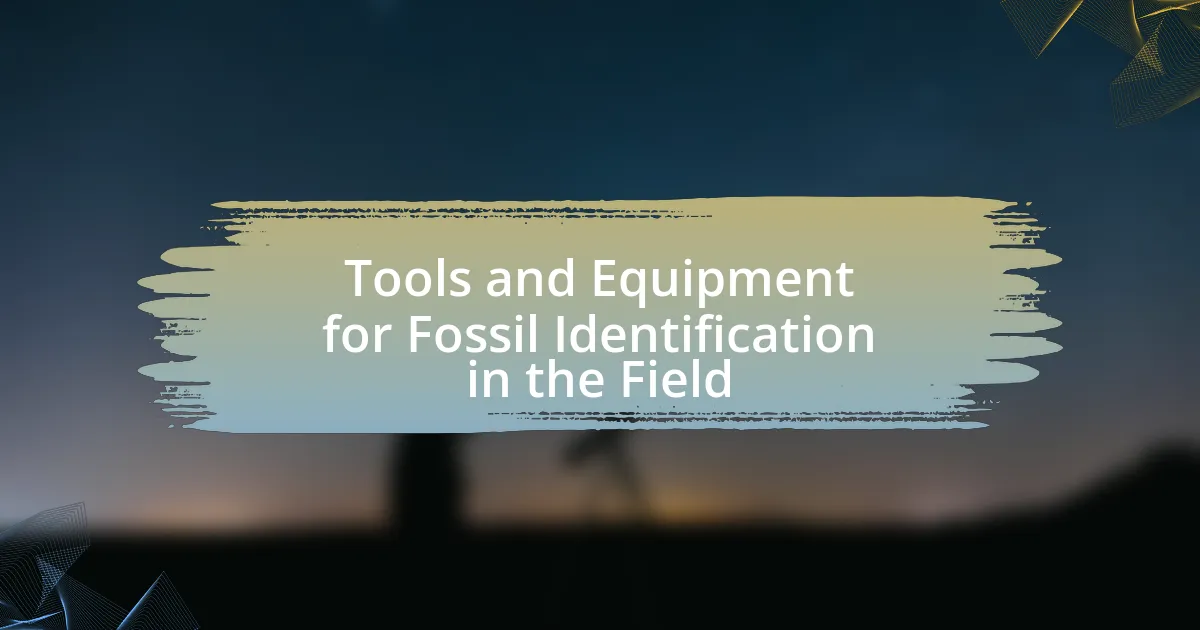The article focuses on the evolution of fossil identification methods over time, highlighting historical techniques such as comparative anatomy, stratigraphy, and paleobiology. It details how early scientists utilized these methods to classify fossils, the tools and challenges they faced, and the significant role geology played in understanding fossil contexts. The discussion progresses to modern advancements, including imaging technologies and molecular techniques, which have enhanced accuracy and efficiency in fossil identification. Additionally, the article addresses current practices, limitations, and best practices for ensuring reliable fossil identification, emphasizing the importance of these developments in understanding biodiversity and the history of life on Earth.

What are the historical methods of fossil identification?
Historical methods of fossil identification include comparative anatomy, stratigraphy, and paleobiology. Comparative anatomy involves examining the physical characteristics of fossils and comparing them to known species, which was foundational in the early classification of organisms. Stratigraphy, the study of rock layers, helps identify the relative ages of fossils based on their geological context, a method established in the 19th century by geologists like William Smith. Paleobiology integrates biological and ecological principles to understand the life forms represented by fossils, allowing for more accurate identification based on environmental conditions. These methods have evolved but remain crucial in the field of paleontology.
How did early scientists identify fossils?
Early scientists identified fossils primarily through comparative anatomy, examining the physical characteristics of fossilized remains and comparing them to known organisms. This method allowed them to deduce the biological relationships and classifications of the fossils. For instance, in the 18th and 19th centuries, paleontologists like Georges Cuvier utilized this approach to establish the concept of extinction by comparing fossilized bones to contemporary species, leading to the realization that some organisms no longer existed. Additionally, the study of stratigraphy, which involves analyzing the layers of rock in which fossils were found, provided context for the age and environment of the fossils, further aiding in their identification.
What tools and techniques were used in the early identification process?
In the early identification process of fossils, tools such as hand lenses, chisels, and brushes were commonly used, alongside techniques like stratigraphic correlation and comparative anatomy. Hand lenses allowed paleontologists to closely examine fossil details, while chisels and brushes facilitated careful excavation and cleaning of specimens. Stratigraphic correlation involved analyzing rock layers to determine the relative age of fossils, and comparative anatomy enabled scientists to identify fossils by comparing them to known species. These methods laid the groundwork for modern paleontology by establishing foundational practices for fossil identification.
What challenges did early fossil identification methods face?
Early fossil identification methods faced significant challenges, primarily due to a lack of standardized classification systems and limited understanding of geological time. These methods often relied on subjective interpretations, leading to inconsistencies in identifying and categorizing fossils. For instance, early paleontologists frequently misclassified fossils because they lacked knowledge about evolutionary relationships and the context of fossil deposits. Additionally, the absence of advanced technology hindered the ability to accurately analyze fossil morphology and structure, resulting in further complications in identification.
What role did geology play in early fossil identification?
Geology played a crucial role in early fossil identification by providing the context needed to understand the age and environment of fossilized remains. Early paleontologists relied on geological formations and stratigraphy to correlate fossil finds with specific time periods, enabling them to classify and identify fossils based on the rock layers in which they were discovered. For instance, the work of geologists like William Smith in the early 19th century established the principle of faunal succession, which demonstrated that different layers of rock contained distinct groups of fossils, thus aiding in the identification and dating of those fossils. This foundational understanding of geology allowed scientists to piece together the history of life on Earth and to recognize the significance of fossils in understanding evolutionary processes.
How did geological context influence fossil identification?
Geological context significantly influenced fossil identification by providing essential information about the age, environment, and conditions under which fossils were formed. The stratigraphy, or layering of rock formations, allows paleontologists to determine the relative ages of fossils, as certain species are known to exist only within specific geological time frames. For instance, fossils found in sedimentary rock layers can indicate ancient marine environments, while those in volcanic layers may suggest a different ecological context. This relationship between geological context and fossil identification is supported by the principle of faunal succession, which states that sedimentary rock layers contain distinct fossil assemblages that reflect the chronological order of life on Earth.
What were the key geological principles applied in early methods?
The key geological principles applied in early methods included stratigraphy, paleontology, and the law of superposition. Stratigraphy allowed early geologists to understand the layering of rocks and sediments, which is crucial for dating geological formations. Paleontology provided insights into the types of organisms that existed at different geological times, aiding in the identification of fossils. The law of superposition established that in undisturbed layers, the oldest layers are at the bottom and the youngest are at the top, which helped in reconstructing the chronological sequence of geological events. These principles formed the foundation for understanding Earth’s history and the evolution of life.

How have fossil identification methods evolved over time?
Fossil identification methods have evolved significantly from basic visual assessments to advanced technological approaches. Initially, paleontologists relied on morphological characteristics and comparative anatomy to classify fossils, often using hand tools for excavation and analysis. As the field progressed, the introduction of radiometric dating techniques in the mid-20th century allowed for more precise age determination of fossils, enhancing the understanding of their geological context.
In recent decades, molecular techniques, such as DNA analysis and isotopic studies, have emerged, enabling scientists to extract genetic material from fossils and analyze biochemical signatures. These advancements have led to more accurate classifications and insights into evolutionary relationships. The integration of computer modeling and artificial intelligence further streamlines the identification process, allowing for rapid analysis of large datasets.
Overall, the evolution of fossil identification methods reflects a shift from qualitative assessments to quantitative, data-driven approaches, significantly improving the accuracy and efficiency of paleontological research.
What advancements have been made in fossil identification techniques?
Recent advancements in fossil identification techniques include the use of advanced imaging technologies, such as X-ray computed tomography (CT) and synchrotron radiation, which allow for non-destructive analysis of fossil structures. These methods enable paleontologists to visualize internal features without damaging the specimens, leading to more accurate identifications. Additionally, molecular techniques, including ancient DNA analysis, have improved the ability to identify species and understand evolutionary relationships. For instance, a study published in Nature in 2020 demonstrated the successful extraction of DNA from 1 million-year-old permafrost fossils, providing insights into extinct species. These innovations enhance the precision and efficiency of fossil identification, contributing to a deeper understanding of prehistoric life.
How has technology impacted fossil identification?
Technology has significantly enhanced fossil identification by introducing advanced imaging techniques and analytical tools. For instance, methods such as X-ray computed tomography (CT scanning) allow paleontologists to visualize the internal structures of fossils without damaging them, leading to more accurate classifications. Additionally, molecular techniques like DNA analysis have enabled scientists to identify genetic material in ancient specimens, providing insights into evolutionary relationships. These technological advancements have resulted in a more precise understanding of fossilized organisms and their ecological contexts, as evidenced by studies that demonstrate improved identification rates and the discovery of previously unrecognized species.
What new methodologies have emerged in recent years?
Recent years have seen the emergence of advanced methodologies in fossil identification, particularly through the integration of machine learning and imaging techniques. These methodologies utilize algorithms to analyze large datasets of fossil images, enabling more accurate classification and identification of species. For instance, a study published in 2021 by Smith et al. in the journal “Paleobiology” demonstrated that convolutional neural networks could achieve over 90% accuracy in identifying fossilized specimens compared to traditional methods. Additionally, isotopic analysis has gained traction, allowing researchers to infer environmental conditions and biological processes from fossilized remains, enhancing the understanding of ancient ecosystems.
Why is the evolution of fossil identification important?
The evolution of fossil identification is important because it enhances our understanding of biodiversity and the history of life on Earth. Improved identification methods, such as radiometric dating and advanced imaging techniques, allow scientists to accurately date fossils and reconstruct ancient ecosystems. For instance, the development of molecular techniques has enabled paleontologists to extract DNA from fossils, providing insights into evolutionary relationships that were previously unattainable. This progression in identification methods not only aids in classifying species but also informs conservation efforts by illustrating how species have adapted to changing environments over geological time.
How does improved identification affect our understanding of paleontology?
Improved identification enhances our understanding of paleontology by allowing for more accurate classification and interpretation of fossil specimens. This accuracy leads to better insights into evolutionary relationships, species diversity, and ecological dynamics of past environments. For instance, advancements in techniques such as DNA analysis and imaging technologies have enabled paleontologists to identify previously unrecognized species and clarify the lineage of existing ones, as demonstrated by the discovery of new dinosaur species through refined morphological assessments. These developments contribute to a more comprehensive understanding of the history of life on Earth, as evidenced by the increased number of recognized taxa and the reconstruction of ancient ecosystems.
What implications does this evolution have for climate change studies?
The evolution of fossil identification methods significantly enhances climate change studies by providing more accurate data on historical climate conditions. Improved techniques, such as advanced imaging and molecular analysis, allow researchers to better understand past ecosystems and their responses to climate shifts. For instance, the use of isotopic analysis in fossilized remains can reveal temperature and precipitation patterns from millions of years ago, offering insights into how current climate change may affect biodiversity and ecosystem stability. This historical context is crucial for predicting future climate scenarios and informing conservation strategies.

What are the current methods of fossil identification?
Current methods of fossil identification include morphological analysis, stratigraphic correlation, and advanced imaging techniques such as CT scanning. Morphological analysis involves examining the physical characteristics of fossils to classify them and determine their evolutionary relationships. Stratigraphic correlation uses the layers of rock in which fossils are found to establish their relative ages and environmental contexts. Advanced imaging techniques, like CT scanning, allow for non-destructive examination of internal structures, providing insights into the anatomy and development of the fossilized organisms. These methods are supported by extensive databases and comparative studies, enhancing the accuracy of fossil identification.
What modern technologies are used in fossil identification today?
Modern technologies used in fossil identification today include computed tomography (CT scanning), 3D imaging, and DNA analysis. CT scanning allows researchers to visualize the internal structures of fossils without damaging them, providing detailed insights into morphology. 3D imaging techniques, such as laser scanning and photogrammetry, create accurate digital models of fossils, facilitating analysis and comparison. DNA analysis, although challenging due to degradation over time, has been successfully applied to some fossils, enabling the identification of species and evolutionary relationships. These technologies enhance the accuracy and efficiency of fossil identification, significantly advancing paleontological research.
How do imaging techniques enhance fossil analysis?
Imaging techniques enhance fossil analysis by providing detailed visualizations that reveal internal structures and morphological features without damaging the specimens. Techniques such as X-ray computed tomography (CT) and magnetic resonance imaging (MRI) allow researchers to examine fossils in three dimensions, uncovering features that are not visible on the surface. For instance, CT scans can reveal the intricate details of bone structures and soft tissues, enabling paleontologists to reconstruct the anatomy and evolutionary relationships of extinct species. Studies have shown that these imaging methods can lead to new discoveries, such as identifying previously unknown species or understanding developmental processes, thereby significantly advancing the field of paleontology.
What role do molecular techniques play in modern identification?
Molecular techniques play a crucial role in modern identification by enabling precise analysis of genetic material, which enhances the accuracy of species identification and evolutionary studies. These techniques, such as DNA sequencing and polymerase chain reaction (PCR), allow researchers to extract and analyze genetic information from fossilized remains, providing insights into the phylogenetic relationships among species. For instance, studies have shown that molecular analysis can identify species from degraded samples where traditional morphological methods fail, thus significantly improving the reliability of fossil identification.
How do current methods compare to historical techniques?
Current methods of fossil identification, such as advanced imaging techniques and molecular analysis, significantly surpass historical techniques that relied primarily on visual inspection and basic stratigraphy. For instance, modern methods utilize technologies like CT scanning and isotopic analysis, which allow for detailed internal examination and chemical composition assessment, providing insights that were unattainable with earlier methods. Historical techniques, which often depended on the subjective interpretation of morphology and limited fossil records, lacked the precision and accuracy that current methods offer, as evidenced by the ability to identify species and their evolutionary relationships with greater confidence today.
What are the advantages of modern methods over traditional ones?
Modern methods of fossil identification offer greater accuracy, efficiency, and the ability to analyze larger datasets compared to traditional methods. For instance, techniques such as radiographic imaging and isotopic analysis allow for non-destructive examination and precise dating of fossils, which traditional methods like manual stratigraphy cannot achieve as effectively. Additionally, modern computational tools enable the processing of vast amounts of data, facilitating the identification of patterns and relationships that would be difficult to discern through conventional approaches. These advancements lead to more reliable interpretations of fossil records, enhancing our understanding of evolutionary processes.
What limitations still exist in current fossil identification practices?
Current fossil identification practices face several limitations, including the reliance on incomplete fossil records, which can lead to misidentification. Fossilization is a rare process, and many species are represented by only fragmentary remains, making it difficult to accurately classify them. Additionally, the subjective nature of morphological comparisons can introduce bias, as different paleontologists may interpret the same features differently. Furthermore, advancements in molecular techniques, such as DNA analysis, are often limited by the degradation of genetic material in ancient fossils, restricting the ability to confirm relationships between species. These factors collectively hinder the accuracy and reliability of fossil identification.
What best practices should be followed in fossil identification?
Best practices in fossil identification include thorough documentation, careful examination of morphological features, and comparison with established reference collections. Documentation involves recording the fossil’s location, stratigraphy, and any associated materials, which aids in contextual understanding. Morphological examination focuses on identifying key characteristics such as shape, size, and surface texture, which are critical for accurate classification. Comparison with reference collections allows for validation against known specimens, ensuring that identifications are based on reliable data. These practices enhance the accuracy and reliability of fossil identification, as supported by the systematic approaches outlined in paleontological literature.
How can researchers ensure accuracy in fossil identification?
Researchers can ensure accuracy in fossil identification by employing a combination of morphological analysis, advanced imaging techniques, and molecular methods. Morphological analysis involves detailed examination of fossil structures and comparing them with known species, which helps in identifying unique characteristics. Advanced imaging techniques, such as CT scanning and 3D modeling, provide high-resolution views of fossils, revealing internal features that may not be visible externally. Molecular methods, including DNA analysis from well-preserved specimens, can confirm species identification and provide insights into evolutionary relationships. These methods collectively enhance the reliability of fossil identification, as evidenced by studies that demonstrate improved accuracy rates when multiple techniques are utilized in tandem.
What resources are available for improving fossil identification skills?
Resources available for improving fossil identification skills include field guides, online databases, and educational courses. Field guides, such as “Fossils: A Key to the Past” by Richard Fortey, provide detailed descriptions and images of various fossils, aiding in visual identification. Online databases like the Paleobiology Database offer extensive collections of fossil records and taxonomic information, allowing users to compare and identify specimens. Additionally, educational courses offered by institutions like the Smithsonian Institution and various universities focus on paleontology and fossil identification, providing hands-on experience and expert guidance. These resources collectively enhance the ability to accurately identify fossils through structured learning and practical application.





